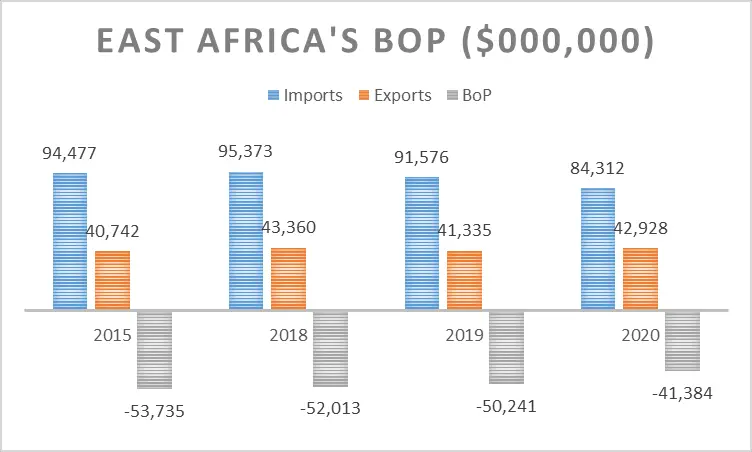East Africa’s Balance of Payment deficit has been as a result of importing more than it exports since 1995. The Balance of Payment deficit increased from $-8,481 million in 1995 to an ever high Balance of Payment deficit of $-53,735 in 2015. Since then, this African region has been working towards recovering from its BoP deficit.
The East Africa region is made up of 19 countries. Most countries in East Africa rely on their agricultural produce for exports. Most imported goods are machinery, motors, electronics, and petroleum products.
The graph below is a snapshot of East Africa’s exports compared with its imports.

What Are the Causes of Improved Balance of Payment Deficit for East Africa?
One of the causes why the Balance of Payment deficit has improved is the reduced importation by countries in this region. In 2015, imports by East African countries were at $94,477 million. In 2020, these countries imported goods worth $84,812 million. This marked an 8% decrease in this African region’s total imports.
The other reason why BoP has improved is due to increased exportation. In 2015, countries that makeup East Africa cumulatively exported $40,742 million. This increased by 5.4% to $42,928 in 2020.
The reduced importation and increased exportation resulted in a lower Balance of Payment deficit from $-53,735 million in 2015 to $41,384 by 2020. This translates to a 77% of BoP deficit in comparison to where the region was in 2015.
How to correct East Africa’s Balance of Payment Deficit?
1. Embrace manufacturing
This is one area in East African countries that has yet to leverage its full potential. If East African countries can embrace manufacturing, they can develop industries to manufacture electronic and motoring components. This would reduce the volume of import of goods that would be produced locally.
Manufacturing can also help these countries to add value to agricultural produce. Instead of exporting them in their raw state as harvested from farms, they can be further processed. Such agricultural products would earn higher incomes after exportation.
East African countries are developing their economies and adapting to fast-evolving technology from developed parts of the world. This makes them desperate to import modern technology in a race against technology. These countries ought to invest enough in research and development to steer forward manufacturing of technological advancements.
2. Subsidizing production
When the government subsidizes production, money from government expenditure is available for production activities like farming and manufacturing. This increases the surplus available for exports to global market. The higher the surplus, the better, as more would be exported to earn countries in this region a foreign exchange.
Some countries are embracing this; Kenya is an example of them. The current regime is focusing on subsidizing more production but not consumption. Other countries must look for applicable economic strategies to boost exportation and add more value to exports.
3. Use contractionary monetary policy
Countries in this region can make their exports more competitive in the global market by devaluing their currency. This is possible through contractionary monetary policies like increasing bank reserves and loan interest rates. This reduces the amount of money in circulation hence the deflation effect.
For those imports whose substitutes are locally produced, imports become quite expensive. People consume more from their local production and thus reducing countries and thus the region’s level of importation.
4. Use contractionary fiscal policies
This is related to reducing government expenditure in the economy. When a government has reduced its expenditure on subsidies (i.e., subsidizing consumption), imports become expensive; hence demand decreases.
Governments in this region can also implement contractionary fiscal policies by raising income taxes. This would reduce the disposable income that citizens in these countries have and reduce their consumption of imports. It would be a way of encouraging consumption from local manufacturers.
